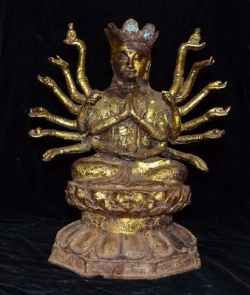Problem of Overstraining the Nervous System / Winds – Lung
What is Lung like…
When many people begin a retreat on a Tibetan Mantra Yoga Sadhana practice that involves visualizing complicated forms, reciting liturgy and reciting mantras, they discover after a week or a month that their minds actually become more agitated than they were before. They may experience pain in the chest or back pain, headaches; they may cry easily and anger easily, too. They may feel anxious, have panic attacks, or insomnia. Some people get depressed. Some people have delusional paranoia, or hear things, or feel strange sensations in their bodies. Others get indigestion, constipation or diarrhea. Lung is often experienced as negative attitude towards the practice (your mind and body want to stop!) so you get doubts about the practice, doubts about your Lama. You may find yourself with extreme negative thoughts. Lung can get so bad if it is not remedied and if the person continues the pattern that causes it, a person can become severely mentally disturbed. But that is rare. Mostly its a good case of negative mind or a nagging obsession that won’t go away. Sometimes lung manifests as aversion to meditating. You just don’t want to go back and sit on that cushion!
My own opinion (which is more or less similar to Venerable Nyingje):
One has to balance both the relative practices and the ultimate practice. Relative practices are practices involving positive conceptual fixation like accumulating merits, purification which will include the ngondros (preliminary practices). It is a very important facet of our practice. Ultimate practice is the direct cause of liberation which means resting in the nature of mind, Mahamudra, Dzogchen. If we can balance both or even carry out both simultaneously then I believe that lung will not arise.
Secondly, one has to emphasize sense of compassion and bodhichitta. If one practices with bodhichitta, then automatically, the heart is open and the inner winds do not collate there (which is an effect of strong grasping). If we emphasize and consider sentient beings all the time, by attuning our daily lives with this sublime attitude, slowly training our minds, then during our actual retreats, or serious practice sessions, i believe that it will be easy to DETECT and AVERT lung because the onset of lung problem is often with a very strong self-concerned attitude which lacks the spaciousness and warmth of the Bodhichitta loving kindness compassion.
Thirdly, one can view whatever lung one has as a purification. Like all purifications, it is a reminder of our grasping and self-fixation. So we learn to relax and balance ourselves. To let go of our extreme rigid views of how practice should be like, views of how good or great or perfect a practitioner we SHOULD be… instead, feel contented. The moment the sense of contentment is gone, the moment we are constantly living for the completion of some task in the future, the conditions are ripe for setting in of lung.
Basically lung comes in from strong hope and fear. Hope for good results and good situations, fear of failure, negative situations etc. Therefore applying the mind training teachings comes in very useful. Our ability as true practitioners should be to utilise both kinds of situations without necessarily being so fearful of one and hopeful of the other. If we can turn both situations into practice, then true progress can be made. That is why we have practices like Tonglen and 8 verses of mind-training which breaks down one’s resistance to suffering. It is in fact one’s own aversion to suffering that contributes largely to the alienation of ourselves from others, which gives further strength to the illusion of ego. When we in fact take on the suffering of others and use that as our path to break ego-clinging and benefitting others, it is a direct shock to this illusion or attachment, and contributes directly to awakening. Thus. this path of the bodhisattva is extremely profound.
